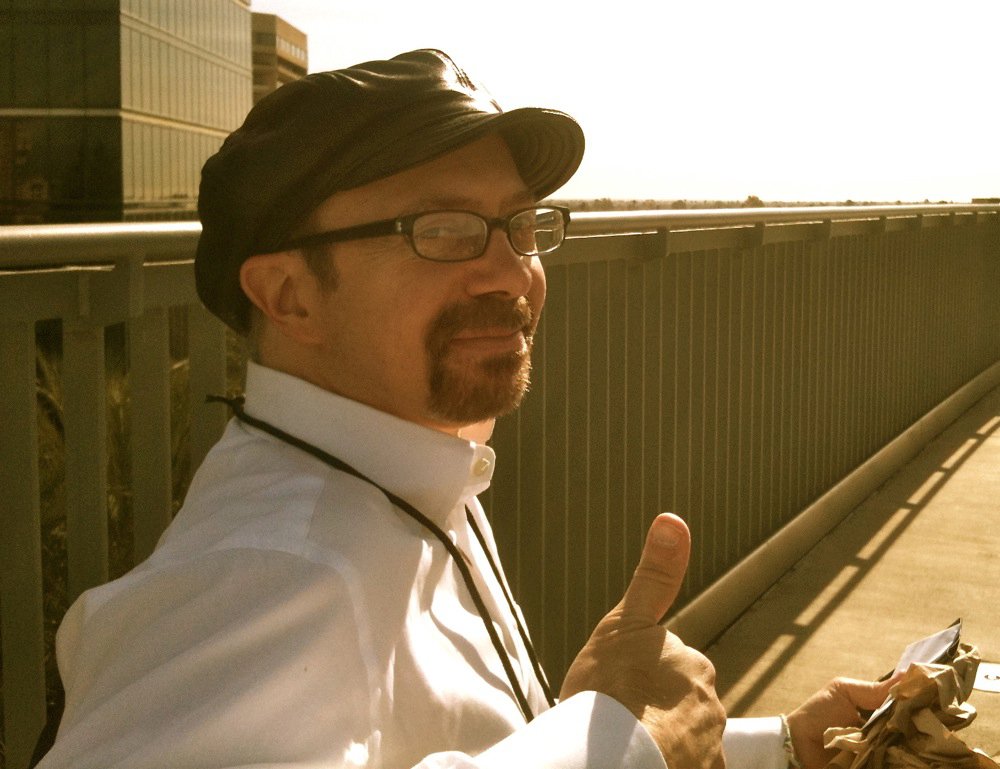
U2's 360° Tour is a massive operation alright, and it wouldn't be an understatement to call it The Greatest Show On Earth - or anywhere else for that matter.
Named after a stage configuration called The Claw - a towering, robotic-looking structure said to be the largest (and costliest) concert setting in rock 'n' roll history, one that offers stadium audiences a panoramic view of the band - it's a long way from "three chords and the truth."
It's five hours before showtime inside the vast Giants Stadium. The field and seats of the 80,000 capacity venue are empty, but I'm suddenly jolted by an overwhelming blast of music produced by three musicians on stage who proceed to pump out the second-best version of City Of Blinding Lights I've ever heard.
Were they The Edge, Adam Clayton and Larry Mullen Jr, they might take their rendition all the way home, but the trio I'm listening to are their techs, Dallas Schoo, Stuart Morgan and Sam O' Sullivan, respectively.
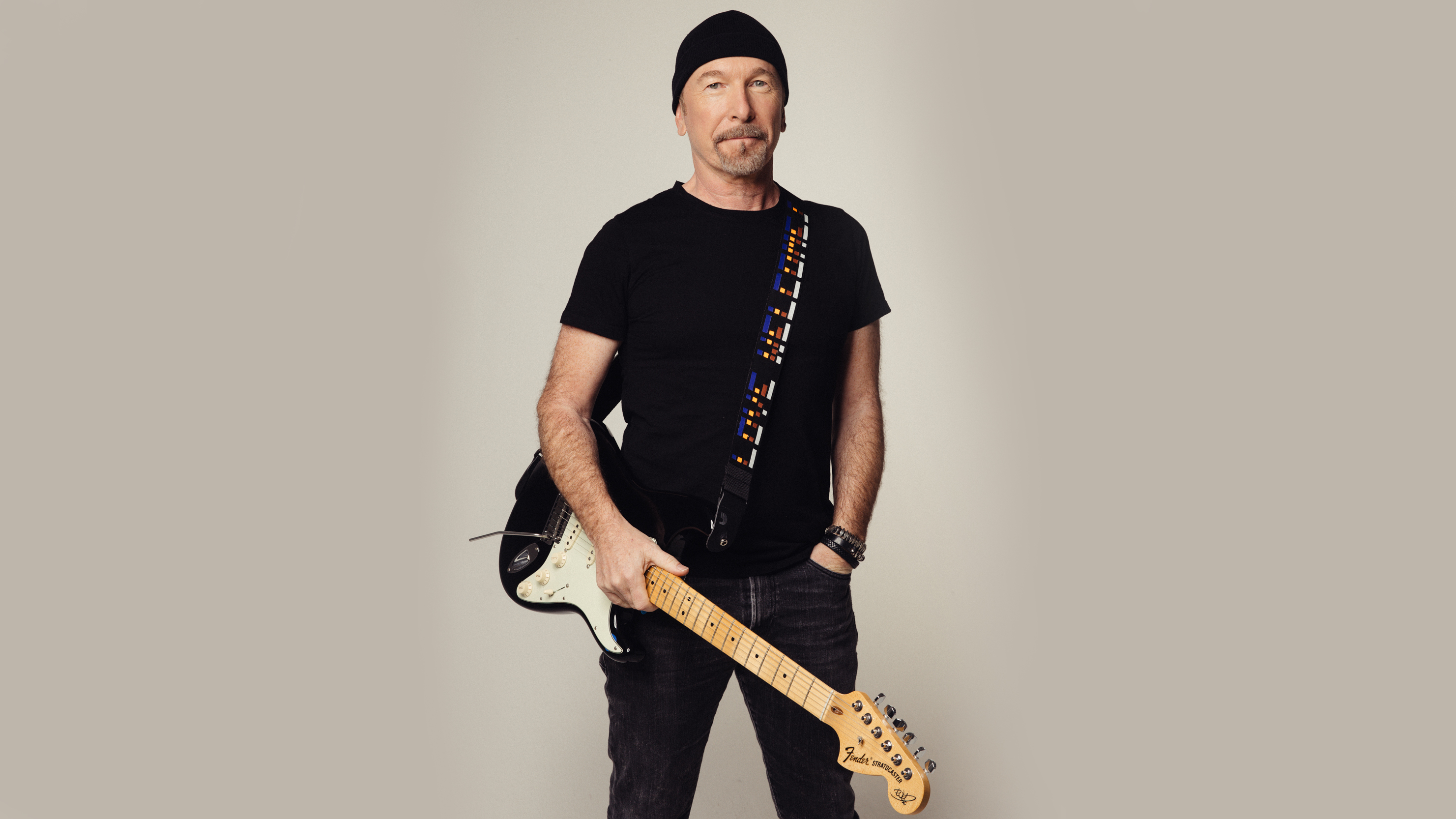
5 underappreciated U2 songs guitarists need to hear by… The Edge
Still, it's uncanny how much they sound like their bosses. Schoo switches guitars and tweaks some settings on Edge's pedalboard. A few more guitar changes - a Rickenbacker, a Music Rising Les Paul, a black Stratocaster - and song snatches follow (bits of Ticket To Ride, The Rolling Stones' Angie and - WTF? - Stairway To Heaven).
Then Schoo sees me and waves me up on stage. The affable Kentucky native greets me warmly as I tell him he and his fellow techs could form the greatest U2 tribute band around. Schoo laughs heartily. When I ask him if U2 are going to attempt to cover Zeppelin tonight, he laughs again and says, "No, no, no. That's just us having fun. We're testing sounds, but we get to play rock star while we work."
With 43 guitars and a truckload of electronic gear (for the complete, definitive list, see the end of this article) to look after, Schoo just might be the hardest working man in the business. While it's The Edge's job to make sonic magic happen nightly, Schoo is up at dawn, mapping out the agenda for each performance, plotting guitar changes and keeping score of ever-changing effect presets.
Want all the hottest music and gear news, reviews, deals, features and more, direct to your inbox? Sign up here.
Oh, and don't forget changing strings on those guitars - on any given day, he's personally stringing 20 of them. "Most are a breeze," he says. "It only starts to feel like a chore when I'm working on a 12-string."

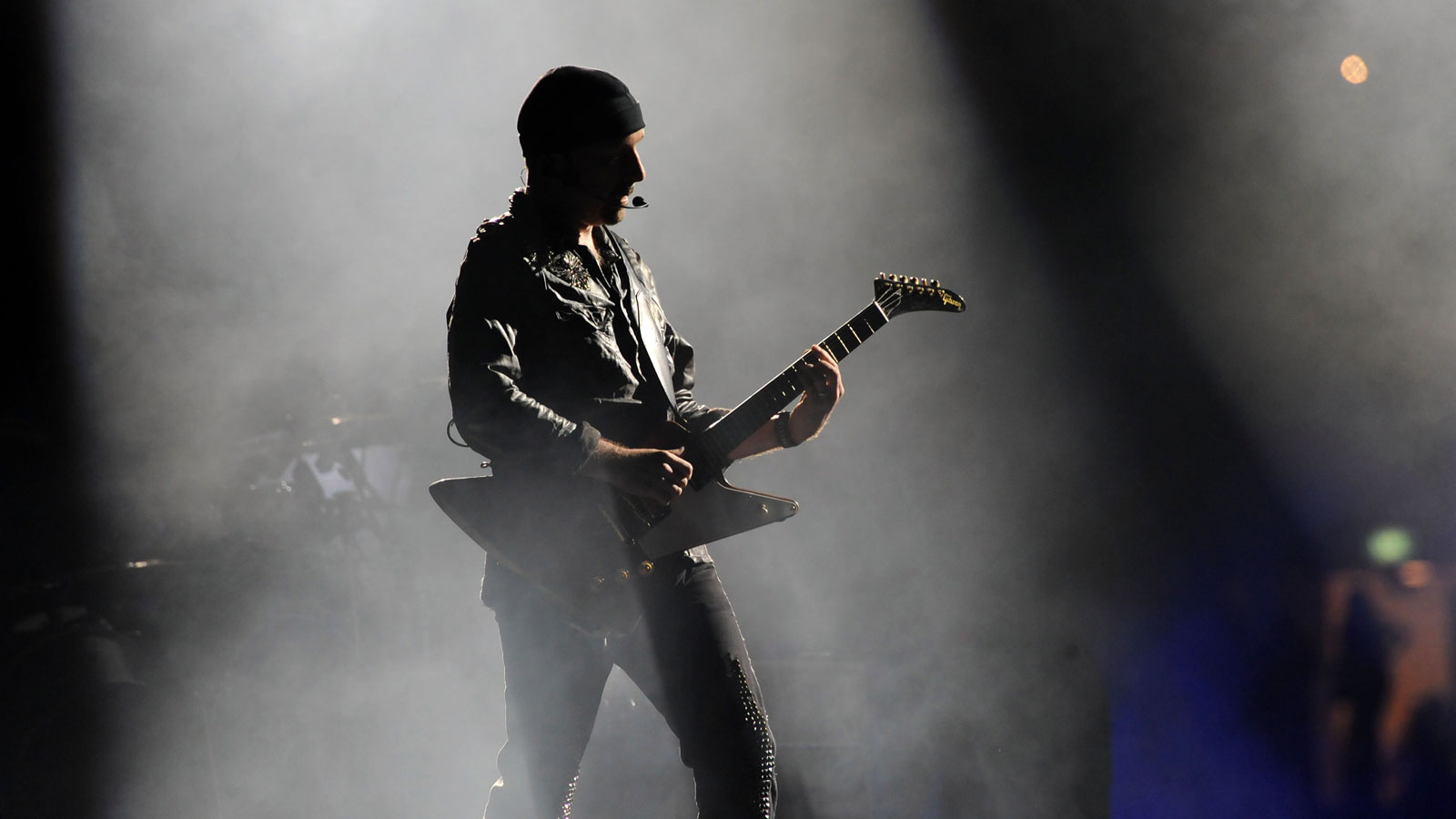
Schoo has been Edge's right-hand man since 1986. Having worked with everyone from Hall & Oates to James Taylor, he got a call to meet with U2 while they were finishing The Joshua Tree. But the offer to go on the road with the Irish band was a difficult one to accept. Schoo asked the iconic concert promoter Bill Graham for advice. Graham, who knew stars when he saw them, told Schoo, "These kids are going to be mega."
Twenty-three years later, Schoo is now not only Edge's guitar tech and full-time employee, but a trusted confidante, staying by the guitarist's side at every single concert and recording session. "That's the most amazing thing about Edge and the band," he says, "the amount of faith they'll have in you if you prove your worth. I still pinch myself when Edge or Bono ask me for ideas in the studio. I think to myself, Hey, you're the geniuses. You wrote the song, you play it - I'm just the hired hand here."
Schoo talks into his two-way that he's going to need "an hour or so," and after receiving confirmation from a production staffer that the time is clear, he takes me on a guided tour of the mind-boggling array of amps, effects and guitars that make up The Edge's sound.
I'm still finding it strange to be standing under an enormous claw, Dallas.
[laughs] "It does take a couple of minutes to get acclimated. But you forget pretty fast. It does look pretty awesome at night with all the lights and the video screen."
Edge is very guitar-specific. Last night he used 21 different guitars for 24 songs
How is it different for The Edge to work on this kind of stage? There's a lot more room for him to move; everything's a lot cleaner.
"That's true. There's more real estate for him to deal with. He isn't as tied to one little area and he doesn't stand next to his pedalboard as much as he used to. That's great in one way because it gives the crowd a very lively show, but it presents sound issues he and I had to figure out.
"During our production rehearsals in Barcelona, when we saw the stage for the first time and the band started getting familiar with it, Edge asked me if I could handle most of the show - meaning, could I man the switching of effects but keep up with the guitars?
"Edge is very guitar-specific. Last night he used 21 different guitars for 24 songs. He's more tuned into the sound of each guitar than he ever was on any other tour. So I've got to stay focused every second. I have to always be ready with a new guitar, and I have to be ready for all of the effects cues."
[Pointing to the large Skrydstrup switching system] But he does have his own pedalboard. He is working his own effects some of the time, right?
"Yes, he is, but every time he walks away from the pedalboard, which is often, it's all on me. And let me tell you, this tour has been a challenge in that respect. During a show, when I'm down there [he points to the stairs that lead underneath the stage], all I have is a six-inch window to look up at him through."
A six-inch window? How can you see him all the time?
[laughs] "I can't. Not all the time. It isn't easy. And what makes it even more difficult is, for the first time ever, Edge has a wireless headset mic so he can sing and work the stage. In the past, he could back off the mic and give me cues. Now he has to try to put his hand over his mic and give me directions, or he tries to do it with certain facial expressions."
How long does it take for you and Edge to be in sync? How long is the rehearsal process between the two of you?
"It can take several weeks. And things change while we're on tour. Certain songs come and go. The good thing is, I've been with him for so long, so there's a history between us. We have a shorthand."
Take me through the amp setup you have here.
"Well, of course we have the main AC30 from '64. Can't do a show without that. Then we have a '58 Fender Deluxe with a Vox speaker and a '57 Deluxe with a Jensen speaker. From there we go to a mid-'50s Fender Harvard - a very rare amp, by the way, and it sounds fantastic - and I put a Vox speaker in that. Plus, we have some early '70s Vox amps as backups."
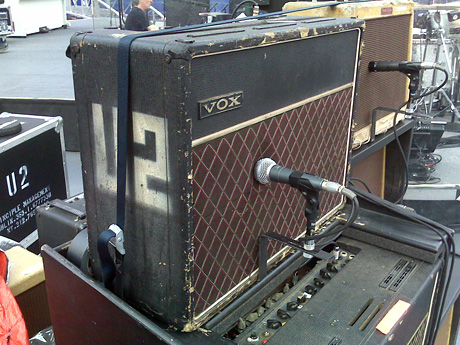
Edge loves that amp so much and he really relies on it. It's probably more important to him than any guitar
But the main star amp-wise is the '64 AC30.
"Absolutely. It's the basis for The Edge's sound, live and in the studio - well, aside from what's in his head and his hands and just the magic he brings to what he does."
Let's go through some specifics of the amp. It's what's known as an 'AC30TB.'
"That's right, it's a 'Top Boost.' The chassis is 1964 but it's housed in a 1970s cabinet - this I how the amp came when Edge originally purchased it. The speakers are a Jensen Blue Alnico 12" from the '60s and a Silver Jensen Alnico 12". I replaced a Blue Alnico in early 1986 for the Silver Jensen because the blue one blew out and that's what I had in the U2 Dublin storage as a replacement."
Could Edge tell the difference between the two speakers?
"Totally. He knows any kind of change I make to that amp. Nothing gets by him. Luckily, he likes the speaker combination, so we stuck with it."
Still, you've had to make some other changes to it over the years. It's certainly not stock.
"It's not stock at all. I have Marshall capacitors in there, Fender capacitors and resistors. It's totally one-of-a-kind, a real Frankenstein. Edge loves that amp so much and he really relies on it. It's probably more important to him than any guitar."
Have you ever had any serious mishaps with it during a show?
"Only a few, thank goodness. But any time something happens, it's serious. The worst time was during the Vertigo tour. The audio just stopped - the power stayed on, but there was no output. Nothing."
That sounds like trouble.
"Oh, you know it. Not only is Edge completely comfortable with that sound, but 95 percent of the presets are going through that amp.
"I quickly got a replacement Vox amp on stage, but even so, it was one of the worst shows ever - I just mean for Edge on a personal level. The crowd had no idea anything was wrong, but he was just so disappointed. When you're up there and you're giving your all but you're not getting the kind of sound you want, it's very dispiriting. I could tell he was frustrated the entire time."
The replacement amp, is it wired the same as the main AC30?
"Pretty much. Of the 14 Vox amps we own, it's the closest to the main AC30, but it just doesn't have the same compression. You can't introduce compression with speakers that don't have mileage on them. Edge calls it 'sparkle' - toppiness.
"Think about the sound he gets from his Strat on Where The Streets Have No Name, that crystal-like sound. That's what 'sparkle' is. It's a special sound you can get from a speaker, and the only way to get it, if the speaker's right, is when it has some mileage on it, when it's been used."
I guess it goes without saying that Edge's AC30 is akin to Clapton's Blackie.
"Oh, it's priceless. If he auctioned it off, I don't know how much it would fetch. I know I take such good care of it. I've taken it on flights and sat it right down next to me in its own first-class seat - there's no way I'd let that thing out of my sight."
I would say that 80 percent of the echoes of the show, Edge is still using his own Korg SDDs 2000s
Let's talk about delay. I noticed that when you guys played City Of Blinding Lights there was that unique delay to the guitar sound, even in an empty stadium. Do you still have the delays set to 3/16ths?
"No. We have new tempos in the show. I would say that 80 percent of the echoes of the show, Edge is still using his own Korg SDDs 2000s, which have to be manually bumped up. You have to go through them to get the right settings. And you can't go down, you have to go up. So you have to go 5, 6, 7, 8, 9 and so on to get to 4. Pride, With Or Without You, Streets - I know what number he wants and I have to change the settings manually. But sometimes the tempos do change, so I have to have it all written down."
And I see that there's no monitors on the stage - is Edge hearing his guitar sound through his earphones?
"Yep. Through his phones and what's coming from behind him. I don't want to say it's a compromise, but it's something he's still getting used to. What's funny is, the sound has been remarkably consistent. From what Edge hears on stage and from what the audience hears way out there, there's no bouncing around of sound."
Let's talk about some of guitars Edge uses on tour. You have a veritable guitar shop you bring around with you.
[laughs] "We do bring a lot, yes. I should be stringing guitars right now, in fact. C'mon, let's go downstairs."
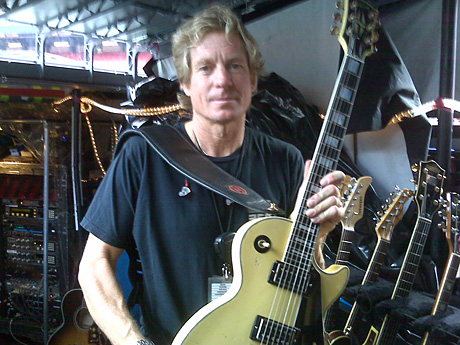
He'll even ask me while he's soundchecking - 'Dallas, are these strings new?' He can tell
We take the stairs down to Dallas's cramped work area, filled with electronic gear and lined with guitars hanging from racks.
My word! How many of these do you string each day?
"Generally, about 18 or 19. Last night was 21. I have a system: the guitars are unloaded off the band truck around 9:30 or 10am, which is when I begin to string and stretch. I can usually have 14 guitars finished by the time the band comes in for soundcheck. Then I try to get another four done right up to when the support band goes on.
"While that's happening, I have almost an hour to get in the last string stretching and tuning on each show guitar. I have a pretty good procedure and rhythm for all of this, but meals often take a back seat or passed on altogether if there additional guitar repairs."
So Edge wants fresh strings every day? He doesn't like a little grit on the strings?
"Nope. And he'll even ask me while he's soundchecking - 'Dallas, are these strings new?' He can tell."
[Pointing to some Gibson Explorers] These guitars here…is one of these the famous '76 Explorer?
"No, we finally retired it. It's such an important guitar for recording that I finally convinced him to leave it home. Nothing serious ever happened to it, but it's spent years in the sun, getting rained on - outdoor shows do that. I wanted to nip things in the bud while I could.
"It's a bright-sounding guitar, very toppy - like the AC30, it's one of the most important components of his sound. So I told him, 'Let me look around. I'll find some amazing replacements,' and I came up with three 1976 Explorers, all with the natural finish.
"The right ones are hard to find because Gibson had two different Explorers in production that year. The ones that were produced from June through December had a thin neck, but the models that were produced during the first part of that year had a thick baseball bat neck. Those are the ones Edge prefers. Gibson didn't make many of them, only about 1800 of them or so, and people hang on to them. Finding a few of them that were just right took some detective work."
[Seeing a faded Alpine White Les Paul] Now, I know Edge auctioned his '75 Les Paul a few years ago…What's this?
[Takes the guitar out of the rack] "Let me tell you a story, Joe. This is the most amazing thing. Yes, The Edge did auction his Les Paul off for Music Rising - it made a phenomenal amount of money. [Ed. Note: final price $288, 000] It was hard for him to part with it."
I can imagine. He used it on New Years Day, Love Comes To Town…
"So many classic songs. It's a crucial guitar for him. But it was a great cause, so he couldn't say no. Anyway, it was Christmas time, and I'm home in Colorado, and this huge UPS package arrives at my door. I open it up and it's a brand-new Gibson case. I'm like, 'OK, what's this?' I flipped the locks on the case and took a look inside and I thought I was seeing things…it was The Edge's '75 Les Paul!"
Wait…Gibson bought it back? I thought it was part of Guitar Center's Legends Collection.
"It is. The second I got this guitar, I started checking it out. Look at this [he flips it over, shows me belt scratches and dings]… it was eerie. I thought somebody made some sort of mistake at first. Did they send me the auctioned guitar to be authenticated or something?
"So I called Edge and said, 'Do you know anything about this?' And he was like, 'No. What are they doing sending it back to you?' Which wouldn't have made any sense: you wouldn't send a guitar like that by UPS; you'd hand deliver it. Edge didn't know what was happening.
"By now, my wheels are really turning. So I unscrewed the back plate…brand-new wiring. Brand-new pots, everything. I keep checking - a brand-new switcher. I take the pickups out…brand-new wood inside."
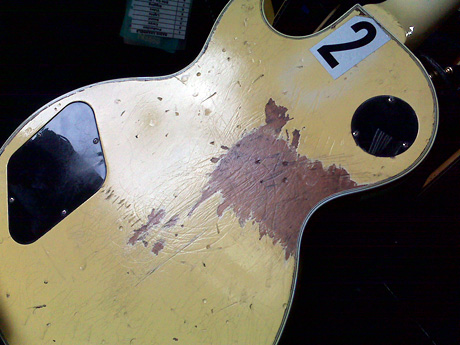
Gibson made a replica of the '75 Les Paul?
"Yep. They made an exact replica. Gibson wanted Edge to have the guitar even though he'd auctioned it off. I still remember when he plugged it in for the first time and played it; he was like, 'This is it! It's the same guitar.' We couldn't believe it.
[He admires the back of the instrument, runs his fingers over the "2" decal] "I mean, look at this. They even got the same decal and faded it just like the original. It's scary! The weight, everything. I mean, how can you get the same weight of the wood - new wood is going to be different than older wood. Totally amazing. Edge used this on No Line On The Horizon, he loved it that much."
How about the '73 black Strat…where is that?
"We've got that one. [He picks a black Stratocaster out of its rack, shows it off.] This is the Where The Streets Have No Name Strat. He also plays Bad and Still Haven't Found with it. It's a beautiful guitar. What I really like about it is the way it returns to pitch even with the standard tremolo system. This was actually his second most important guitar after he got the Explorer. Lot of history on this baby.
"The maple neck on this guitar is so bright. This guitar through the AC30 with an old analog delay - that's a magical combination. You give Edge those tools and he'll take you places with them."
Any new guitars that you're dealing with?
"Mmmm…There's this '64 Epiphone Casino that he uses on the opening song Breathe; that sounds pretty nice. Then there's a Fernandes Sustainer that he uses on a new version of Ultra-Violet."
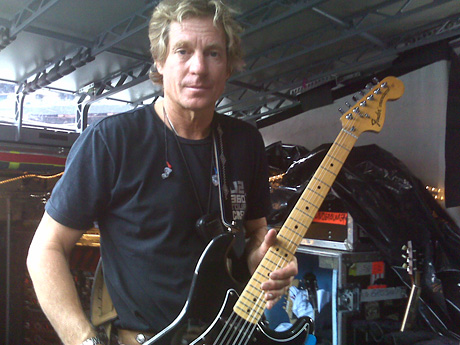
I remember you were trying to get them to play that song again for the longest time.
[laughs] "Yes, I love that song! For years I've been asking them to do it again. Of course I don't know if I can claim credit for them putting it back in the set or whether they just figured it was time. But they are, and the Fernandes sounds incredible on it."
Edge started going wireless on this tour, didn't he?
"He did. He wanted to move around more and work the stage - it's that kind of show. But as of three nights ago, we went back to wires; we're plugged in again. The reason is pretty obvious: the signal is direct and true. Wireless, it was fine. But there's no comparison."
How are the Death By Audio pedals working out?
"Oh, they're great! We're using the Supersonic Fuzz Gun and the Harmonic Transformer. This guy, Ben Curtis - great guy - he makes these different distortion pedals and he turned us on to them.
"At first, I didn't know if Edge was going to be able to use them. They sounded a bit like white noise to me - white noise with some parameters. But Edge heard them and he was like, 'No, no, there's something there.' And he started hooking them up to his echoes, and voila! he started making music.
"The Fuzz Gun is on No Line On The Horizon, that big intro sound. It's on Ultra-Violet, too - it's fantastic. The guy is always looking for something new that can create music, and he'll tinker with a pedal or a device for days until he can make it do something he wants."
Edge and I have a great relationship and his trust in me is very gratifying
In addition to working with The Edge on tour, you're also with him in the studio - you're a full-time employee.
"That's right. Edge and I have a great relationship and his trust in me is very gratifying, so yes, I do work with the band in the studio. Any time guitars and amps need set up for recording, I'm there - wherever that is!" [laughs]
On the new album, were there any times that you helped Edge out with a guitar sound, if there was something he was stuck on?
"There was an instance on the new record where something like that occurred. It's usually Bono who will say to me, 'I'm having trouble on such-and-such a song, Dallas. I need the right attitude, I need some inspiration. Before Edge gets here, can you work on some things, come up with a guitar or effects?' And of course, it's extremely flattering when he does that.
"There was a song called Stand Up [Comedy], that… the guys were in a bit of a rut. It was good, but they were frustrated. They didn't feel it was going to that next level. We were in Olympic Studios. Bono was sitting on the couch writing lyrics. Steve Lillywhite came in and said, 'There's no juice to the song. The middle-eight isn't happening. There's no inspirational sound to it. I think we should just cut it from the record and move on.' Danny Lanois and Brian Eno were in total agreement.
"Now, I'm thinking, The Edge is the best guitar player in the world. I know he can make this song work. So Bono said to me, 'Dallas, this song can fly. Can you go into the studio and think of something?'
"So I went in and I turned on three distortion pedals and an analog echo. I plugged in the Explorer and I came up with this really offensive distortion sound. But then I did something: I turned the volume on the guitar off, hit a chord and then I cranked the volume knob."
You worked it like a volume pedal.
"Yeah! It created this incredible siren-like sound. All of a sudden, every face in the studio lit up and Bono was like, 'Edge, get in there! That's it!' Edge raced in, took the guitar from me, and at that point it was all in his hands; he found the right note patterns, the right places to play, and he totally turned the song around and made it a winner."
Still, it wouldn't have happened without you.
[He shrugs modestly] "Ah, you get lucky sometimes."
The definitive guide to The Edge's live equipment
Special thanks to Dallas for providing us with the following, comprehensive list of The Edge's live setup on the 360° Tour. From guitars and amps right down to strings, slides and straps, it's all detailed here for the first time:
The Edge's under-stage effects rack:
1. Furman Pro Rack Power (110V)
2. KORG SDD Digital Delay (VOX) (240V)
3. Korg SDD 3000 Digital Delay (240V)
4. Line 6 DM4 Pro(A) Custom made rack device
5. Line 6 DM4 Pro (B) Custom made rack device
6. TC 2290 Digital Delay ("A") (240V )
7. TC 2290 Digital Delay "(B") (240V)
8. Line 6 Pod Pro(110V) (A)
9. Line 6 Pod Pro (110V) (B)
10. Korg A3 Multi Effects (240V)
11. TC 2290 Digital Delay (C)
12. TC 2290 Digital Delay (D)
9b. KORG A3 Rack Multi Effects Unit (110V) (B)
13. Furman Pro Rack Power #2
14. Eventide H3000 Harmonizer
15. Lexicon PCM80 Digital Effects Processor
16. Lexicon PCM70 Digital Effects Pro
17. Custom Audio Elec AMS Interface
18. AMS SDMX Digital Delay (A)
19. AMS SDMX Digit Delay (B)
20. Custom Audio Elec Remote Wah
21. Custom Audio Elec Dual Stereo Mixer
22. Rocktron Bradshaw DVC Pedal VCA
23. Custom Audio Amp Selector
24.Custom Audio Patch Point (110V)
25. Skrydstrup MR9 Loop System (A)
26. Skrydstrup MR9 Loop System (B)
27. Skrydstrup MR9 Loop System (C)
28. Skyrdstrup System Interface
29. Electrix "Filter Factory"
The Edge's outboard effects pedals:
30. Durham Electronics "SexDrive" Dist pedal
31. BOSS CS-3 Compressor Sustain pedal
32. DIGITECH "Synth Wah" Pedal
33. Death By Audio "HARMONIC TRANSFORMER" Dist Pedal
34. Death By Audio "FUZZ GUN"
35. Electro Harmonix " POG" pedal
36. Line6 DM4 Distortion pedal
37. Death By Audio "Soundwave Breakdown"
38. Boss Noise Suppressor NS-2
39. Boss EQ GE-7 pedal
40. Skrydstrup "Bufferooster" pedal
41. Boss FET FA-1 Amplifier
42. Drive Breaker Distortion pedal
The Edge's main onstage pedalboard:
Skrydstrup SC1 + SC1 Extensions + Extension Plus Controller + Dunlop Crybaby Rack Wah Controller, Digitech WH1 Whammy Pedal,
Peterson V-SAM Tuner
Dallas' offstage pedalboard:
Skrydstrup SC1 + SC1 Extension+ Extension Plus
The Edge's onstage amplifiers:
1964 VOX AC30TB Grey Panel
1970's VOX AC30TB Grey Panel
1972 VOX AC30TB Grey Panel
1957 Fender Tweed Deluxe
1958 Fender Tweed Deluxe
1959 Fender Tweed Deluxe
1956 Fender Harvard
The Edge's offstage amplifiers:
1974 VOX AC30TB Red Panel
2008 Marshall 50Watt 1987X Amp Head
1966 4 X 12" Closed Back Cabinet w/Celestion Vintage Speakers (Mick Ralphs owned)
The Edge's wireless guitar system:
(8) SHURE U4RS Dual Receivers
(13) SHURE UR1-J5 Beltpacks (Individually Set/dedicated gain Structures to Each Show Guitar)
"Rab Tronix" (6) Way Selector Box
The Edge's tour guitars:
Gibson 2005 "Music Rising" Les Paul
Gibson 2006 "Music Rising" Les Paul
Gibson 1976 Natural Explorer
Gibson 1976 Natural Explorer (spare)
Epiphone 1962 Sunburst Casino
Epiphone 1964 Sunburst Casino w/Bigsby
Fernandes 2003 Native Sustain Guitar
Fernandes 2009 Retro Rocket Sustain Guitar
Fender 1975 Brown Custom Telecaster
Fender 1966 Cream Telecaster w/Maple Neck
Fender 1969 Cream Telecaster w/Maple Neck
Gretsch 1963 Chet Atkins Walnut Country Gentleman
Gretsch 1968 Chet Atkins Walnut Country Gentleman
Gretsch 2009 Chet Atkins Walnut Country Gentleman w/Piezo Fishman Acoustic System
Gretsch 1959 Sunburst 6101 Country Club
Gibson 1966 Cherry SG Les Paul Standard
Gibson 1965 Pelham Blue SG Les Paul Standard
Fender 1968 Tobacco Stratocaster w/Rosewood Neck
Fender 1973 Cream Stratocaster w/Maple Neck
Fender 1975 BlondeTelecaster w/Rosewood Neck
Fender 1974 Black Telecaster w/Maple Neck
Gibson 1973 Cream Les Paul Custom
Gibson 2008 Cream Replicated Les Paul
Fender 1973 Black Stratocaster w/Maple Neck
Fender 1976 Black Stratocaster w/Maple Neck
Fender 1974 Black Stratocaster w/Maple Neck
Rickenbacker 1966 Fireglo 330-12
Rickenbacker 1966 Fireglo 330-12(Spare)
Rickenbacker 1967 Maple Rickenbacker 330-12
Rickenbacker 1967 Maple Rickenbacker 330-12(Spare)
Rickenbacker 1968 Black 325
Gibson 2008 Sunburst SJ-200 Acoustic/Electric
Gibson 2006 Blonde "Pete Townshend" SJ-200 Acoustic/Electric
Gibson 2008 Blonde SJ-200 Acoustic/Electric
Gibson 2005 Sunburst J-45 Acoustic Electric
Martin 1972 Natural D12-28 Acoustic/Electric
Martin 2009 Natural D12-28 Acoustic/Electric
Epiphone 1966 Sunburst Texan Acoustic/Electric
Fender 1994 Arctic White Telecaster(Japanese)
Line 6 2005 Red/Black "Variax" Modelling Guitar
Gretsch 2009 Black G6136 Falcon w/Fishman Piezo Acoustic System
Fender 2009 Sunburst American Vintage '52 Telecaster w/Piezo Acoustic System
MOOG 2009 MG-001 Tobacco Sunburst Sustain Guitar
The Edge's guitar strings:
D'Addario EXL110 XL Reg Lite .10-.46
D'Addario EXL115 XL Blues Jazz .11-.49
D'Addario EXL116 XL Medium Top Heavy .11-.52
D'Addario EXL 140 Light Top/Heavy Bottom .10-.52
D'Addario EXL 150 Light Elec 12 String .10-.46
D'Addario Phosphor Bronze Wound EJ15 Extra Light .10-.47
D'Addario Phosphor Bronze Wound EJ26 Custom Light .11-.52
Martin MSP 400 Bronze .10-.47
Martin MSP 4050 Bronze Custom Light .11-.52
Martin M500 Extra Light Acoustic Bronze 12 String .10-.47
Ernie Ball P02233 12 String Electric .009-.046
The Edge's additional instruments and show accessories:
YAMAHA CP80 Electric Piano + Roland JC 120 Combo Amplifier
EBOW hand held Sustain Chrome and Plastic Electronic Bow
D'andrea medium Nylon Picks
Herdim German Medium Nylon Picks
Datum Machining/Dallas Schoo Custom Machined Finger Brass Slides
Dunlop Brass Full Slides
Levy Leather Guitar Straps
Dallas Schoo Uses Peterson VS-R Strobo Rack Tuner, Peterson V-Sam Tuner, Peterson VS-Strobo Flip, Boss TU12 Guitar Tuner
Liked this? Now read: The best cheap electric guitars, The top 10 stompboxes we can't live without and 7 best low-powered tube amp heads under £300
Joe is a freelance journalist who has, over the past few decades, interviewed hundreds of guitarists for Guitar World, Guitar Player, MusicRadar and Classic Rock. He is also a former editor of Guitar World, contributing writer for Guitar Aficionado and VP of A&R for Island Records. He’s an enthusiastic guitarist, but he’s nowhere near the likes of the people he interviews. Surprisingly, his skills are more suited to the drums. If you need a drummer for your Beatles tribute band, look him up.
